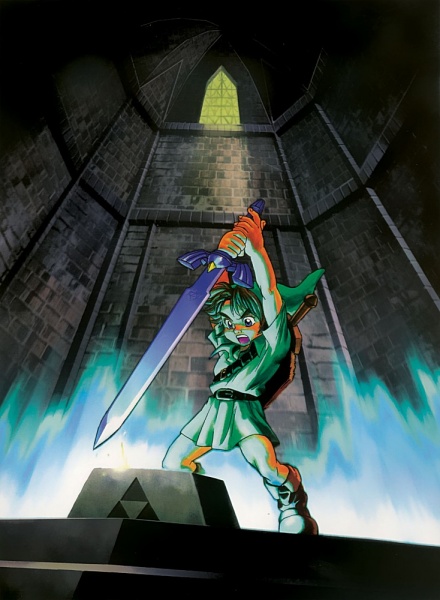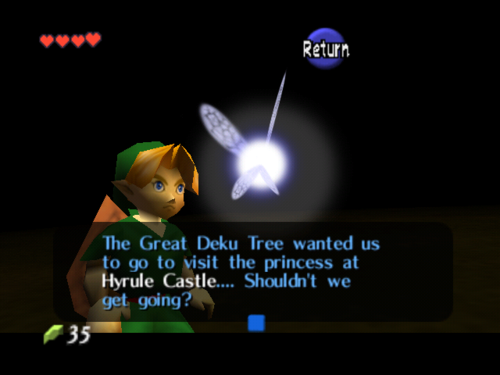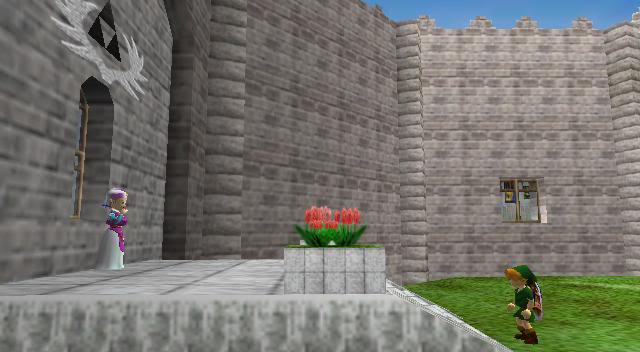What do you Love about Ocarina of Time?
Posted on November 22 2013 by Legacy Staff
 After discussing nearly every other game in the franchise, we finally reach this legendary title, thanks to a request from ZD reader “Link and Zelda.” Ocarina of Time is commonly considered to be not only the best game in the series, but the best video game of all time, period. That’s a bold statement to make, but the N64 title surpassed expectations at the time and its revolutionary gameplay and design contributed to the advancement of the video game industry. Of course, such a feat has been accomplished by previous Zelda games, such as The Legend of Zelda and A Link to the Past, but this game took the series in a brand new direction and introduced fans to a 3D Hyrule. This would be a trend that nearly every home console Zelda title would follow. With that said, I’m not going to focus most of my points on how revolutionary the game was, but more on the individual aspects that still make Ocarina of Time a worthwhile adventure to play through today.
After discussing nearly every other game in the franchise, we finally reach this legendary title, thanks to a request from ZD reader “Link and Zelda.” Ocarina of Time is commonly considered to be not only the best game in the series, but the best video game of all time, period. That’s a bold statement to make, but the N64 title surpassed expectations at the time and its revolutionary gameplay and design contributed to the advancement of the video game industry. Of course, such a feat has been accomplished by previous Zelda games, such as The Legend of Zelda and A Link to the Past, but this game took the series in a brand new direction and introduced fans to a 3D Hyrule. This would be a trend that nearly every home console Zelda title would follow. With that said, I’m not going to focus most of my points on how revolutionary the game was, but more on the individual aspects that still make Ocarina of Time a worthwhile adventure to play through today.
The Story
This should come as no surprise. Almost every Zelda game has had a rich story, but Ocarina of Time‘s is something special. Not only is it well told, but it is currently the only game in the series that causes a split in the timeline. Long before the official timeline was revealed, there was much debate over the game’s ending. Did Adult Link’s world simply vanish, or did it continue to exist? The release of The Wind Waker solidified people’s opinions that there were indeed two timelines (since it was obvious that the child timeline continued with Majora’s Mask). However, just a couple years ago it was revealed that there were actually three timelines after the events of Ocarina of Time.
What also makes the story so intriguing is the irony that the good intentions of young Link and Zelda are ultimately what cause the future they were attempting to prevent. As Link travels through time to undo the damage for which he was partially responsible, he causes a split in the world’s timeline, resulting in more Links and Zeldas facing cataclysms in various periods and realities (but, good news for us, we get more Zelda games!). Ocarina of Time definitely had the strongest impact on the series’ timeline and is to this today one of the best Zelda stories ever told.
Child Link/Adult Link
 It seems that ever since A Link to the Past, several Zelda games have been playing with a “two-worlds” mechanic to increase the size of the world and story in a relatively efficient way. A Link to the Past, Oracle of Ages, Oracle of Seasons, The Minish Cap, Twilight Princess, and of course Ocarina of Time all utilized this mechanic. But Ocarina of Time is definitely one of my favorites. Generally, this mechanic is used for alternate worlds, but here it’s simply the present and future. What intrigues me about this is that you go from a relatively peaceful world to one of complete chaos: and you’re to blame. Many parts of Hyrule seem unchanged, but as soon as you exit the Temple of Time as Adult Link, you see just what Ganondorf has done, and it strikes the player with a “I can’t believe this has happened” feeling that, if you ask me, none of the other games have captured quite as well. If I had one complaint about this mechanic, though, it is that it is underutilized. In the other games, you’re constantly going back and forth between worlds to progress, but in Ocarina of Time, there’s generally no travel between time periods. You go from Child Link to Adult Link and rarely have to have go back and forth. Of course I’m not forgetting the Bottom of the Well or the first half of the Spirit Temple, but that’s pretty much it. You can conquer Adult Link’s first three dungeons without ever going back in time. Nevertheless, the story is told so captivatingly that one could argue that constant time travel would damage the story’s fluidity. Although there’s no way of knowing that for sure, I wouldn’t argue against it. The story itself is superb as is.
It seems that ever since A Link to the Past, several Zelda games have been playing with a “two-worlds” mechanic to increase the size of the world and story in a relatively efficient way. A Link to the Past, Oracle of Ages, Oracle of Seasons, The Minish Cap, Twilight Princess, and of course Ocarina of Time all utilized this mechanic. But Ocarina of Time is definitely one of my favorites. Generally, this mechanic is used for alternate worlds, but here it’s simply the present and future. What intrigues me about this is that you go from a relatively peaceful world to one of complete chaos: and you’re to blame. Many parts of Hyrule seem unchanged, but as soon as you exit the Temple of Time as Adult Link, you see just what Ganondorf has done, and it strikes the player with a “I can’t believe this has happened” feeling that, if you ask me, none of the other games have captured quite as well. If I had one complaint about this mechanic, though, it is that it is underutilized. In the other games, you’re constantly going back and forth between worlds to progress, but in Ocarina of Time, there’s generally no travel between time periods. You go from Child Link to Adult Link and rarely have to have go back and forth. Of course I’m not forgetting the Bottom of the Well or the first half of the Spirit Temple, but that’s pretty much it. You can conquer Adult Link’s first three dungeons without ever going back in time. Nevertheless, the story is told so captivatingly that one could argue that constant time travel would damage the story’s fluidity. Although there’s no way of knowing that for sure, I wouldn’t argue against it. The story itself is superb as is.
Z-Targeting System
 Ocarina of Time is known for its groundbreaking elements in the series and video games in general, and the one that comes to mind first for me is the Z-Targeting system. Many people will argue that other games came up with the same 3D targeting system first, and quite frankly, I don’t know enough about those other games to argue one way or the other. I do know, however, that this was at least one of the first games to implement such a system, and that it did so almost flawlessly. Every 3D Zelda title since has allowed Link to lock on to enemies to make combat easier and faster. But that’s not all! When a target is not nearby, the Z button can be used as a “battle ready” mode that allows Link to backflip, sidestep, and defend while running. They may seem menial, but players will find themselves using these abilities often, and they can be invaluable during certain parts of the game, such as the Sacred Meadow passageways. For the franchise’s first attempt at a 3D world, Link handles extremely well and his controls in subsequent games have changed very little, as this first experiment was excellent. Bravo Nintendo!
Ocarina of Time is known for its groundbreaking elements in the series and video games in general, and the one that comes to mind first for me is the Z-Targeting system. Many people will argue that other games came up with the same 3D targeting system first, and quite frankly, I don’t know enough about those other games to argue one way or the other. I do know, however, that this was at least one of the first games to implement such a system, and that it did so almost flawlessly. Every 3D Zelda title since has allowed Link to lock on to enemies to make combat easier and faster. But that’s not all! When a target is not nearby, the Z button can be used as a “battle ready” mode that allows Link to backflip, sidestep, and defend while running. They may seem menial, but players will find themselves using these abilities often, and they can be invaluable during certain parts of the game, such as the Sacred Meadow passageways. For the franchise’s first attempt at a 3D world, Link handles extremely well and his controls in subsequent games have changed very little, as this first experiment was excellent. Bravo Nintendo!
The Forest Temple
While I find Ocarina of Time‘s Forest Temple to be one of the strongest dungeons in the series, I’m not including it on this list so much because of the dungeon itself, but it encapsulates many of my “favorites” of the game, including (obviously) dungeon, item, boss, and music. First of all, the dungeon itself feels leaps and bounds more challenging than any of Child Link’s dungeons. It lets you know that Adult Link’s journey will be much more treacherous, and rightfully so. There’s a scary atmosphere to it all that makes it a great introduction to the second half of the game, and the music plays a large role in that. I’ve said before that this is my favorite dungeon theme in the entire series, and it never fails to give me goosebumps every time I play it. The ghostly chanting is mysterious and chilling. Take a listen below to refresh your memory.
http://www.youtube.com/watch?v=hmsZyC0UXUU
This dungeon also possesses my favorite item of the game, Link’s trademark projectile weapon, the Bow. This is the first time we’ve been able to use the weapon in a 3D title, and it’s rewarding how much it feels like using an actual bow. In the overhead style games, the bow simply fired arrows in whichever direction you were facing. Essentially, you were limited to four directions. Now the directions are limitless, and with the first person perspective, Ocarina of Time made a gigantic leap forward in the realism of wielding a bow compared to any previous Zelda game. Lastly, the dungeon is ruled by my favorite boss of the game, Phantom Ganon. I love both phases of this fight, but the first phase, while easy, keeps with the scary vibe of the dungeon. Those creepy dark paths on the paintings are frightening enough without a horseman eerily charging toward you, whether he were to actually pop out of the paintings or not. But he does. And that just adds to the creepy factor.
In summary, the Forest Temple is awesome.
Having a Partner
 Ocarina of Time was the first Zelda game to do lots of things, but I feel this one is really worth mentioning. Nearly every game since has followed this trend, and for good reason. Navi may have been annoying, but let’s be honest, she fulfilled her purpose and was a fitting, diegetic way to get information across to the player. The only problem that this may have inadvertently caused is that now partners tend to hold your hand a little too much (We’re all thinking of Fi right now, I’m sure). However Ocarina of Time had a fair amount of hand holding without blatantly shoving the next intended path in front of your face. Unlike Fi, Navi rarely forces you to listen to what she has to say, and while her nagging can be annoying, it can usually be ignored. However she’s always there if you need a hint, something I feel the older Zelda titles lacked. I like exploration as much as the next Zelda fan, but sometimes if I find myself unable to progress, I’m not in the mood to cluelessly scour the entire map for the solution. Just point me in the general direction, and I can figure it out from there without feeling like I cheated. And that’s what Navi and subsequent partners have provided us with ever since Ocarina of Time.
Ocarina of Time was the first Zelda game to do lots of things, but I feel this one is really worth mentioning. Nearly every game since has followed this trend, and for good reason. Navi may have been annoying, but let’s be honest, she fulfilled her purpose and was a fitting, diegetic way to get information across to the player. The only problem that this may have inadvertently caused is that now partners tend to hold your hand a little too much (We’re all thinking of Fi right now, I’m sure). However Ocarina of Time had a fair amount of hand holding without blatantly shoving the next intended path in front of your face. Unlike Fi, Navi rarely forces you to listen to what she has to say, and while her nagging can be annoying, it can usually be ignored. However she’s always there if you need a hint, something I feel the older Zelda titles lacked. I like exploration as much as the next Zelda fan, but sometimes if I find myself unable to progress, I’m not in the mood to cluelessly scour the entire map for the solution. Just point me in the general direction, and I can figure it out from there without feeling like I cheated. And that’s what Navi and subsequent partners have provided us with ever since Ocarina of Time.
What do you all think? What do you love about Ocarina of Time? Do you agree or disagree with the points above? Which game do you want to discuss next? Comment below, and let’s talk about it!
Games already discussed:
The Legend of Zelda
The Adventure of Link
A Link to the Past
Link’s Awakening
Oracle of Ages
Oracle of Seasons
The Wind Waker
Four Swords
Four Swords Adventures
Twilight Princess
Phantom Hourglass
Spirit Tracks
Skyward Sword




